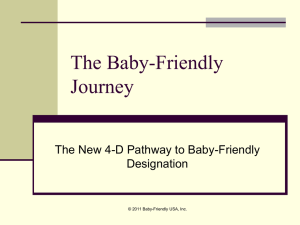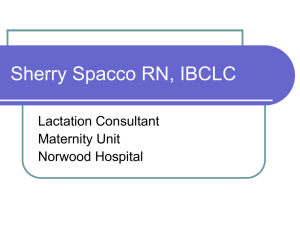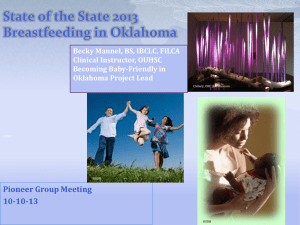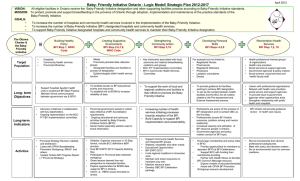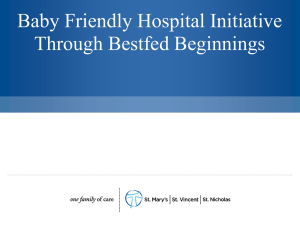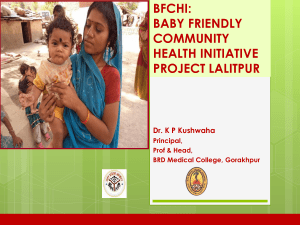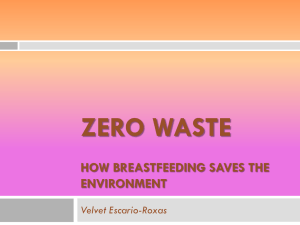The Importance of Becoming Baby-Friendly Designated
advertisement
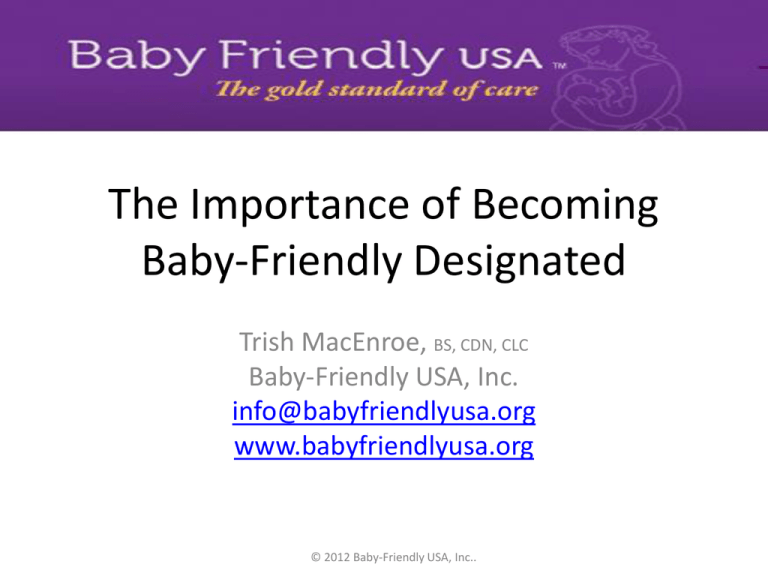
The Importance of Becoming Baby-Friendly Designated Trish MacEnroe, BS, CDN, CLC Baby-Friendly USA, Inc. info@babyfriendlyusa.org www.babyfriendlyusa.org © 2012 Baby-Friendly USA, Inc.. SPEAKER DISCLOSURES • The speaker discloses employment with BabyFriendly USA, Inc. • There are no other conflicts of interest. • This presentation is not supported by any funds from companies that violate the International Code of Marketing of Breast Milk Substitutes. INTERNATIONAL DATA • UNICEF reports that there were nearly 20,000 Baby Friendly Hospitals worldwide. (2006) US DATA • 156 Designated Facilities • 595 working towards designation – 11 facilities are finishing up the COI program (Assessment Results and QI Projects) – 222 facilities in the Discovery Phase – 274 facilities in the Development Phase – 74 facilities in the Dissemination Phase – 25 facilities in the Designation Phase ~3250 total birthing facilities in US Why pursue Baby-Friendly designation? Benefits to the Hospital © 2012 Baby-Friendly USA, Inc.. Claim Leadership Role in Answering the Nation’s Call: • • • • Healthy People 2020 goals for breastfeeding Improving the CDC m-PINC scores Surgeon General’s Call to Action to Support BF National Prevention Strategy for Health & Wellness • Institute of Medicine – Obesity Prevention Policies Top 10 Benefits to the Hospital • # 10 - Elevate the facility reputation by receiving a globally prestigious award • # 9 - Enhance the environment of competence among staff • # 8 - Enhance leadership and team skills among staff © 2012 Baby-Friendly USA, Inc.. Top 10 Benefits to the Hospital • # 7 - Deliver evidencebased, patient-centered care • # 6 - Improve patient satisfaction • # 5 - improve health outcomes for mothers and babies © 2012 Baby-Friendly USA, Inc.. Top 10 Benefits to the Hospital • # 4 - demonstrate a commitment to quality improvement • # 3 - meet corporate compliance requirements • # 2 - meet Joint Commission perinatal core measures for exclusive breast milk feeding © 2012 Baby-Friendly USA, Inc.. Top 10 Benefits to the Hospital • # 1 - Babies are born to be breastfed © 2012 Baby-Friendly USA, Inc.. The Pathway to Baby-Friendly® Designation Dissemination Collect Data Baby-Friendly Designation Designation Bridge to Designation Phase Dissemination Certificate of Completion Implement QI Plan Readiness Interview On-Site Assessment Train Staff Bridge to Dissemination PhaseDevelopmentCertificate of Completion Data Collection Plan Staff Training Plan Prenatal/Postpartum Teaching Plans Development Start Discovery Register with Baby-Friendly USA Obtain CEO Support Letter Complete Self Appraisal Tool © 2012 Baby-Friendly USA, Inc.. Bridge to Development PhaseRegistry of Intent Award Hospital Breastfeeding Policy BFHI Work Plan BF Committee Or Task Force © 2012 Baby-Friendly USA, Inc.. DISCOVERY • Information Packet – What is the BFHI – 10 Steps – International Code of Marketing of Breast Milk Substitutes • Self Appraisal Tool • Sample CEO Support Letter © Baby-Friendly USA, Inc. 2010 13 DEVELOPMENT • • • • • • • Guidelines and Evaluation Criteria Model Action Plans Budget planner Policy development tool Policy check off tool Community survey Patient education planning template © Baby-Friendly USA, Inc. 2010 14 DEVELOPMENT • • • • • Staff training requirements Staff training planning template Staff education documentation tool Data Collection planning template BFHI power point presentation © Baby-Friendly USA, Inc. 2010 15 BFUSA Support • Review and provide feedback – Action Plans – Infant feeding policy – Staff training plan – Patient education plan – Data collection plan © Baby-Friendly USA, Inc. 2010 16 DISSEMINATION • Audit tools – Code implementation – Policy implementation – Staff competency – Staff knowledge – Training implementation – Patient knowledge – Infant Feeding Outcomes © Baby-Friendly USA, Inc. 2010 17 DESIGNATION • BFUSA/Facility participate in Readiness Assessment Telephone Interview • Facility works with purchasing department to implement requirement to purchase infant formula, bottles and nipples • Facility preparation for the on-site assessment • BFUSA support in planning for on-site assessment © Baby-Friendly USA, Inc. 2010 18 To attain Baby-Friendly designation, a birth facility: • Implements the Ten Steps to Successful Breastfeeding • Invites a Baby-Friendly survey team when it is determined that the Ten Steps are in place. • Undergoes an on-site survey looking at the knowledge and practice of staff and the experience of mothers and babies © Baby-Friendly USA, Inc. 2010 19 The Assessment Team • The team creates a report that blinded and then sent out to an external review board. • This board reviews the report and determines whether the facility receives the Baby-Friendly designation. • Results are available within 6 to 8 weeks of assessment. © Baby-Friendly USA, Inc. 2010 20 Most Important Document © 2012 Baby-Friendly USA, Inc.. BFUSA GUIDELINES AND EVALUATION CRITERIA ON-LINE Guideline - the standard of care to strive to achieve for all patients Criteria for Evaluation – the minimum standard that must be achieved in order to become designated as Baby-Friendly Always strive to achieve 100%. © 2012 Baby-Friendly USA, Inc.. Name that Guideline LET’S PLAY © 2012 Baby-Friendly USA, Inc.. © 2012 Baby-Friendly USA, Inc.. Do the nursing staff in the NICU require training in all 15 lessons? GLEC page 8 Guideline says: “Training for nursing staff ON MATERNITY should comprise a total of 20 hours, inclusive of the 15 sessions identified by UNICEF/WHO plus 5 hours of supervised clinical experience. The facility should determine the amount and content of training required by staff in other units and roles by their anticipated workplace exposure to mothers and babies.” © 2012 Baby-Friendly USA, Inc.. INTENTIONALLY BROAD WORDING • There are wide variations in facility structure and operations throughout the country. • The guidelines cannot address each facility’s specific situation. • For example, some facilities will rotate their prenatal nurses onto the maternity floor – If yes, provide the full 15 lessons to those staff – If no, provide training appropriate to their specific duties © 2012 Baby-Friendly USA, Inc.. NICU STAFF - SIMILAR SITUATION The NICU is vitally important to the BFHI, but is not included in the current assessment Consider if NICU nurses are rotated onto the maternity floor – If yes, provide the full 15 lessons to those staff – If no, provide training appropriate to their specific duties © 2012 Baby-Friendly USA, Inc.. Do we have to train all staff, including housekeeping? GLEC page 8 Guideline says: The facility should determine the amount and content of training required by staff in other units and roles by their anticipated workplace exposure to mothers and babies…The content and number of hours of training for staff working outside maternity will be developed by each facility, based on job description and workplace exposure to breastfeeding couplets. © 2012 Baby-Friendly USA, Inc.. Training for all staff Logically, all staff who have contact with mothers, including housekeeping, should have – basic understanding of the importance of exclusive breastfeeding – know their role with supporting the BF couplet – feel comfortable with witnessing the practices that support breastfeeding – know who to call if a mother has a question or problem with breastfeeding © 2012 Baby-Friendly USA, Inc.. May we accept training that meets the BFHI requirements that occurred prior to employment? GLEC page 8 Guideline says: If training acquired prior to employment with this facility is accepted, as a means of meeting the minimum competencies, the designated health care professional will be able to describe the process used to verify the previously acquired competencies. © 2012 Baby-Friendly USA, Inc.. Development Phase Training Plan Asks the facility to describe – If prior training will be accepted – What evidence of training completion will be accepted – How the program will be evaluated to determine if all lessons were covered – How staff competencies will be verified © 2012 Baby-Friendly USA, Inc.. What topics should be covered in prenatal education? . GLEC page 10 Guideline says the education should cover: • The importance of exclusive breastfeeding • Basic breastfeeding management (including the importance of early skin-to-skin contact, early initiation of breastfeeding, rooming-in, baby-led feeding, how to develop milk supply, effective positioning and attachment) • Individualized education on the documented contraindications to breastfeeding and other special medical conditions © 2012 Baby-Friendly USA, Inc.. What is the definition of skin-toskin? GLEC page 30 Definition says: Skin-to-skin contact refers to contact between the newborn infant and its mother (although in the case of incapacitation of the mother, another adult such as the baby’s father or grandparent may hold the baby skin-to-skin). After birth, the healthy term baby should be completely dried and the baby should be placed naked against the mother’s naked ventral surface. The baby may wear a diaper and/or a hat, but no other clothing should be between the mother’s and baby’s bodies. The baby and mother are then covered with a warmed blanket, keeping the baby’s head uncovered. STS contact should continue, uninterrupted, until the completion of the first feeding (or for at least 1 hour if the mother is not breastfeeding). STS contact should be encouraged beyond the first hours and into the first days after birth. © 2012 Baby-Friendly USA, Inc.. Which mothers and babies need to be placed skin-to-skin and when?. GLEC page 11 says: Step 4 applies to all healthy mothers and babies regardless of infant feeding choice. © 2012 Baby-Friendly USA, Inc.. What Step requires staff to teach hand expression to breastfeeding mothers? GLEC page 13 Step 5 says: Show mothers how to breastfeed and how to maintain lactation even if they are separated from their infants. GLEC page 13 Evaluation Criteria: At least 80% of those who are breastfeeding will report that they were shown how to express their milk by hand. © 2012 Baby-Friendly USA, Inc.. Which babies and mothers should “room-in” during their post-partum stay?. GLEC page 16 Step 7 Guideline says: The facility shall provide rooming-in twenty-four hours a day as the standard for mother-baby care for healthy, full term infants, regardless of feeding choice. © 2012 Baby-Friendly USA, Inc.. Which mothers need to be taught baby feeding cues? GLEC page 17 Step 8 says: This step applies to all babies, regardless of feeding method, and is not interpreted as “Encourage feeding on cue”. © 2012 Baby-Friendly USA, Inc.. Can Baby-Friendly hospitals provide pacifiers to their patients? GLEC page 18 Guideline says: Breastfeeding babies should not be given pacifiers by the facility, with the exception of limited use to decrease pain during procedures when the baby cannot safely be held or breastfed…babies who are being tube-fed in NICU, or for other rare, specific medical conditions. © 2012 Baby-Friendly USA, Inc.. What kinds of breastfeeding support information should be shared with breastfeeding women? When should this information be shared? GLEC page 19 Step 10 says: Breastfeeding women should be given information about community programs such as LLL or WIC in addition to hospital based breastfeeding support at the time of discharge. © 2012 Baby-Friendly USA, Inc.. YOUR CHALLENGE • Review the Guidelines and Evaluation Criteria • Consider your particular circumstances and how you will implement them in the context of – Resources • Staffing • Physical plant – Your circumstances © 2012 Baby-Friendly USA, Inc.. HOW THE 4-D PATHWAY HELPS FACILITIES SUCCEED © Baby-Friendly USA, Inc. 2010 © 2012 Baby-Friendly USA, Inc.. 40 To help foster an understanding that Baby-Friendly is a facility initiative, not just a lactation project… © Baby-Friendly USA, Inc. 2010 © 2012 Baby-Friendly USA, Inc.. 41 4-D Pathway Requires • CEO Letter of Support • Formation of multi-disciplinary team to implement the BFHI Guidelines • Creation of multi-disciplinary team to review the results of mPINC and BFUSA self-appraisal tool and develop a workplan to address low scoring areas © Baby-Friendly USA, Inc. 2010 42 To help ensure that the facility infant feeding policy is comprehensive and that other facility policies do not countermand the infant feeding policy… © Baby-Friendly USA, Inc. 2010 © 2012 Baby-Friendly USA, Inc.. 43 4-D Pathway Provides • Development Phase – Policy development guidance tool – Policy check off tool – review and feedback on the policy • Dissemination Phase – Provide quality improvement audit tool • Designation Phase – Inquire about policy changes, review policy during assessment © Baby-Friendly USA, Inc. 2010 44 To help facilities consider how they will ensure that all staff are fully trained and have the competencies needed to provide evidence-based, patient-centered care that promotes optimal infant nutrition and mother baby bonding… © Baby-Friendly USA, Inc. 2010 © 2012 Baby-Friendly USA, Inc.. 45 4-D Pathway Provides • Development Phase – – – – – Training plan template that addresses key issues List of required training topics Training document tool Review and feedback on training plans • Dissemination Phase – Provide quality improvement audit tools • Designation Phase – Review of curriculum and training records during assessment © Baby-Friendly USA, Inc. 2010 46 To help facilities consider how they will provide and document consistent, evidence-based patient education… © Baby-Friendly USA, Inc. 2010 © 2012 Baby-Friendly USA, Inc.. 47 4-D Pathway Provides • Development Phase – Patient education plan template that addresses key issues – List of required patient education topics – Review and feedback on patient education plans • Dissemination Phase – Provide quality improvement audit tools • Designation Phase – Review of education curriculum, materials and records during assessment © Baby-Friendly USA, Inc. 2010 48 To help facilities measure their performance and infant feeding outcomes to evaluate their implementation of the BabyFriendly Guidelines and Evaluation Criteria… © Baby-Friendly USA, Inc. 2010 © 2012 Baby-Friendly USA, Inc.. 49 4-D Pathway Provides • Development Phase – Data collection planning document – Data collection plan template • Dissemination Phase – Provide quality improvement audit tools • Designation Phase – Readiness assessment telephone interview to assist in determining facility preparedness for the on-site assessment © Baby-Friendly USA, Inc. 2010 50 Re-designation Process Maintaining excellence © 2012 Baby-Friendly USA, Inc.. 51 Success is a journey…not a destination • Achieving Baby-Friendly designation is an important part of the journey…but it is not the end point • On-going data collection and quality improvement activities are vital to ensuring that facilities maintain the standard of care they worked hard to achieve © Baby-Friendly USA, Inc. 2010 52 Re-Designation Process • Designation is for 5 years • Beginning in 2017 Re-designation will be conferred through an on-site assessment • Current re-designations are conducted through a review of data and quality improvement projects © Baby-Friendly USA, Inc. 2010 53 Re-Designation Procedure 2012 - 2016 3 Phases: – Phase I – Step 1 - Infant Feeding Policy and Code Compliance – Phase II – Step 2-10 Compliance – Audit of Practices – Phase III – Implementation of Quality Improvement Plans © Baby-Friendly USA, Inc. 2010 54 BFUSA Annual Monitoring Process Facilities audit practices on assigned steps and conduct QI projects as necessary © 2012 Baby-Friendly USA, Inc.. BFUSA Annual Monitoring • Designated facilities audit practices and conduct QI projects on 2 steps per year • Steps are assigned by BFUSA • Audit Tools are provided by BFUSA • There is an annual fee to BFUSA © 2012 Baby-Friendly USA, Inc.. Baby-Friendly Re-Designation Reaffirm Code Implementation Review Patient Outcomes data Baby-Friendly Re-Designation Review/update Staff Education Review/update Patient Education On-Site Re-Assessment Re-verify Staff Competency Reinstitute QI Activities Review policies © 2012 Baby-Friendly USA, Inc. Re-Designation is the same as the Dissemination and Designation Phases © 2012 Baby-Friendly USA, Inc.. © 2012 Baby-Friendly USA, Inc.. Annual QI and Re-designation • Utilize the same Audit Tools as the Dissemination Phase of the 4-D Pathway FOR MORE INFORMATION: www.babyfriendlyusa.org info@babyfriendlyusa.org 508-888-8092 (9-5 Eastern, M-F) © Baby-Friendly USA, Inc. 2010 © 2012 Baby-Friendly USA, Inc.. 60
